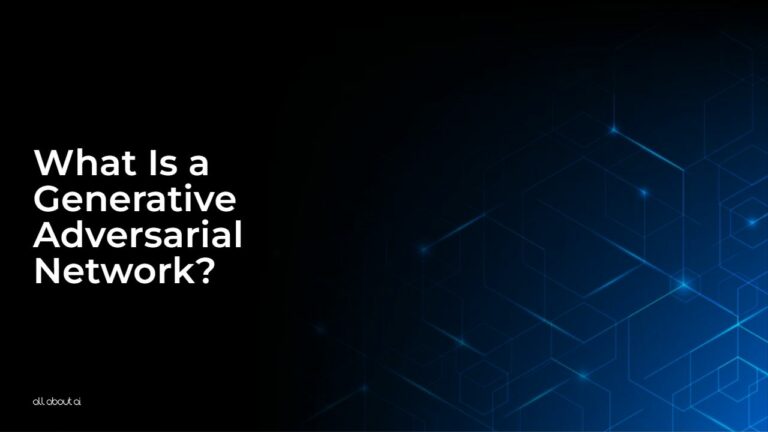What is a Generative Adversarial Network? A Generative Adversarial Network (GAN) is an advanced structure in artificial intelligence, characterized by two neural networks contesting against each other. One network, the generator, creates data mimicking real datasets, while the other, the discriminator, evaluates its authenticity. This competition enhances the accuracy and realism of the generated data.
Dive deep into the world of GANs with guidance from the AI specialists at All About AI. Our comprehensive articles and insights break down intricate AI concepts, making them accessible to everyone.
Examples of Generative Adversarial Network
Art Creation: GANs have revolutionized digital art by generating unique artworks, blending different styles and elements. By analyzing thousands of artistic pieces, these networks can create innovative art that pushes the boundaries of traditional media, opening new avenues for digital artists and designers.
Realistic Game Environments: Video game development benefits from GANs through the creation of lifelike, dynamic environments. These networks analyze real-world textures and landscapes to produce realistic gaming scenarios, enhancing player immersion and providing a more engaging experience in virtual worlds.
Deepfake Technology: GANs are pivotal in creating deepfakes, synthesizing human images and videos. They analyze facial features and expressions to generate convincing fake media, often indistinguishable from real footage. This technology raises significant ethical questions while showcasing the advanced capabilities of artificial intelligence in media manipulation.
Fashion Design: In the fashion industry, GANs assist in designing new clothing lines by analyzing current trends and past designs, generating innovative and stylish fashion items. This application streamlines the design process, allowing designers to experiment with various styles and patterns quickly and efficiently.
Use Cases of Generative Adversarial Network
Drug Discovery: GANs aid in accelerating the drug discovery process. By simulating molecular structures and predicting their interactions, they help identify potential new pharmaceutical compounds. This application significantly reduces the time and cost associated with traditional drug development methods, potentially leading to faster medical advancements.
Voice Generation: GANs are used in generating realistic human-like voices. This technology is instrumental in creating virtual assistants and improving communication systems for the visually impaired, offering a more natural and accessible user experience in various applications.
Predictive Maintenance: In manufacturing, GANs forecast equipment failure by analyzing patterns in machinery performance data, enabling timely maintenance and reducing downtime. This application not only enhances efficiency but also improves safety in industrial settings by preempting potential malfunctions.
Weather Forecasting: GANs enhance weather prediction models by analyzing vast climatic datasets, improving accuracy in forecasting extreme weather events and aiding in climate research. This use case is crucial for disaster preparedness and environmental management, providing valuable insights into weather patterns and climate change effects.
Pros and Cons
Pros
- GANs excel in generating high-quality, realistic data, mimicking real-world scenarios with remarkable accuracy.
- These networks continuously evolve through their adversarial process, leading to improvements in both the generation and discrimination of data.
- GANs have a wide range of applications, from art creation to scientific research, showcasing their versatility in various fields.
- They are particularly effective in unsupervised learning, where they can learn to generate data without explicit labeled examples.
Cons
- GANs require significant computational resources and data, making them less accessible for smaller organizations or individuals.
- The training process for GANs can be unstable and complex, often requiring careful tuning of parameters.
- There is a potential ethical concern with the use of GANs, especially in the creation of deepfakes, which can be used maliciously.
- GANs sometimes produce artifacts or unrealistic outputs, particularly in the early stages of training or with insufficient data.
FAQs
What Are the Components of a GAN?
Generative Adversarial Networks comprise two main components: the generator, which is responsible for creating data, and the discriminator, which is responsible for evaluating the authenticity of the generated data.
How Do GANs Learn?
GANs learn through a competitive process where the generator tries to produce data that the discriminator cannot distinguish from real data, continuously improving through this adversarial interaction.
What Are the Ethical Implications of GANs?
The ethical implications of GANs include concerns around deepfake technology and privacy, as they can generate realistic images and videos that might be used for misinformation or violate personal privacy.
Can GANs Be Used for Good?
Yes, GANs have numerous beneficial applications such as in healthcare for drug discovery, in art for creative expression, and in technology for improving AI models and simulations.
Key Takeaways
- GANs consist of two neural networks, the generator and discriminator, working in opposition.
- They are capable of generating highly realistic data, useful in numerous fields including art, gaming, and scientific research.
- Training GANs is computationally intensive and requires careful parameter tuning.
- Ethical considerations, especially regarding deepfakes, are crucial in the application of GANs.
- GANs have shown promising results in diverse applications like drug discovery and predictive maintenance.
Conclusion
Generative Adversarial Networks represent a significant advancement in AI, capable of generating remarkably realistic data. Their applications span various sectors, reflecting their versatility and potential. The applications of GANs are as diverse as they are impactful, stretching across multiple sectors and industries.
In art and design, GANs have opened new doors for creative expression, enabling the synthesis of artworks that meld styles and elements in ways previously unattainable.
This article answered the question, “what is a generative adversarial network.” To learn more about various AI terminologies and concepts, explore our comprehensive AI Lexicon.





